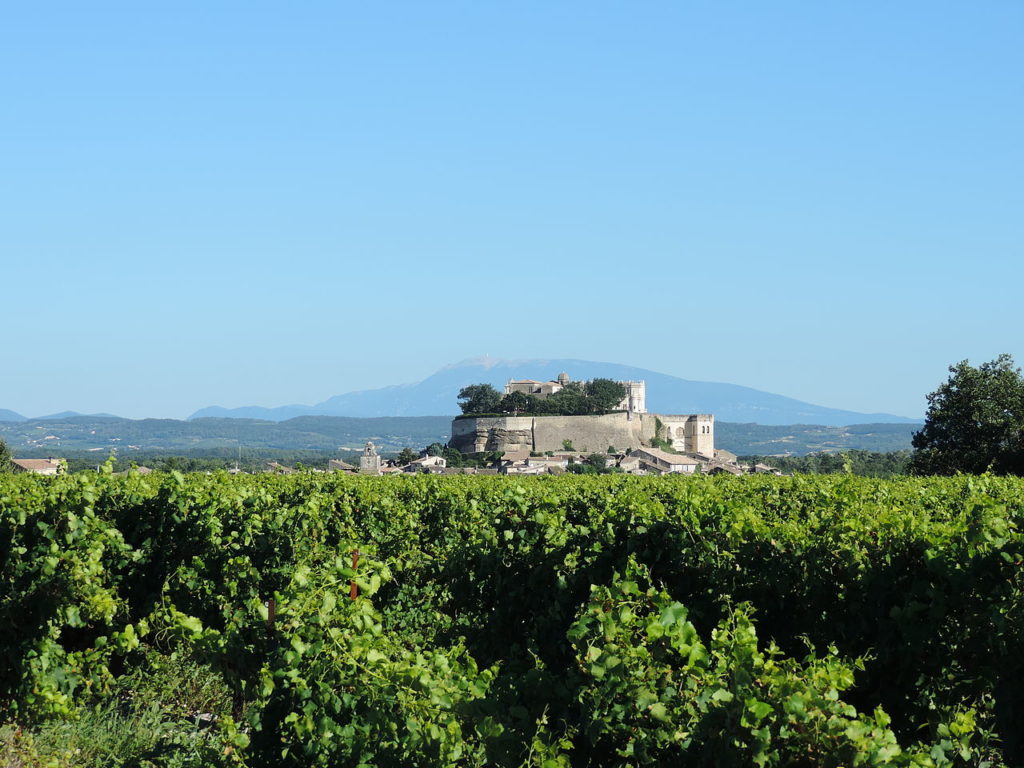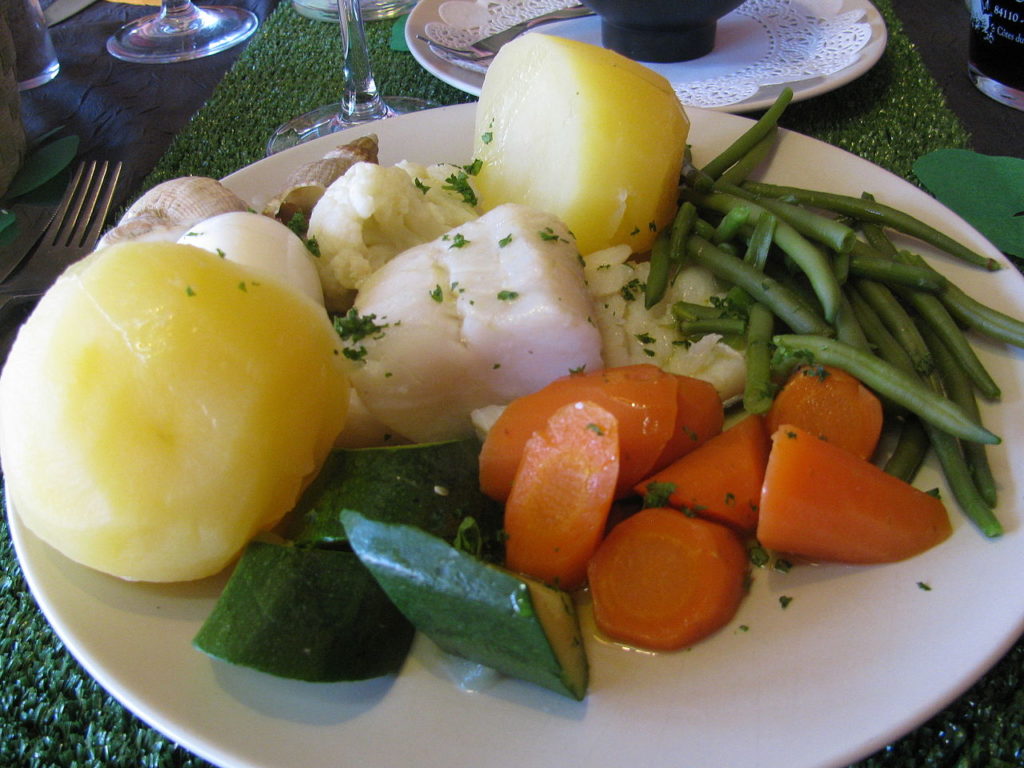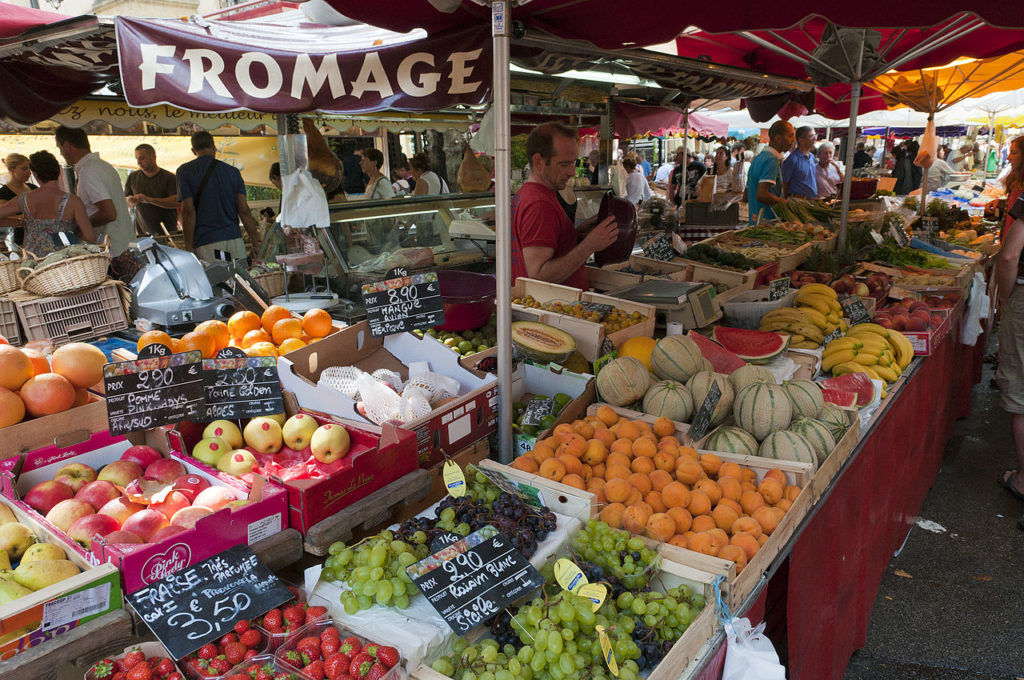Imagine the food of Provence and you’re sitting in cafés watching the world go by and enjoying leisurely meals in peaceful squares beside a fountain in the dappled sunlight. Or at least that’s what any mention of the food of Provence does for me.

Provence is one of France’s greatest regions for food. Its long coastline on the Mediterranean gives it the freshest fish and seafood; the hinterland that stretches behind offers pasture full of sheep, olive groves and fruit orchards. With its balmy climate, Provence became a wine-producing area after the Greeks founded Marseille, making it France’s oldest wine growing region. The food of Provence is truly inspiring.
Provençal cooking is, like the rest of life in this gorgeous region, simple. It concentrates on the best fresh ingredients in season like tomatoes, peppers, garlic and saffron, anchovies, wild herbs and olive oil…lots of it.

Food of Provence Ingredients
Fish and Seafood
With its long Mediterranean coast, and inland rivers and lakes, Provence is strong on fish. Along the coast, you’ll find fish markets from small to large so if you’re self-catering this is a great opportunity to try out new ingredients and new recipes. Or just light a barbecue and grill the sea’s harvest with bunches of rosemary and thyme. Marseille is one of the great harbors of the south with trawlers and small fishing boats supplying the fishmongers in Marseille’s Vielle Port.

Fruit
Provence is full of small market gardens, with the valleys of the Rhône and Durance the largest fruit- and vegetable-producing areas of France. Dessert grapes are produced in the Vaucluse; figs and almonds around Aix, and oranges and lemons everywhere in the Alpes-Maritimes region. The Menton lemon festival in February transforms the town into one vast citrus fest, celebrating the food of Provence.

Meat
Provence is not known for its meat as it has never been a big animal-rearing area. The goats of Provence are bred for providing cheese rather than meat. But if you’re in Sisteron in Haute-Provence, try the special lamb which is tender and sweet.

Olives and Olive Oil
Olive groves, many of which have been here for centuries, fill the landscape. Between April and June, the trees blossom then produce their fruit which becomes gorged with oil and goes from green to black.

Olive oil was considered so important that French kings were baptized with it from the 5th century to the French Revolution. The Provence climate is perfect for olive trees, which is great as it takes 5 kilos of olives to make 1 litre of olive oil. The olive harvest for oil begins in early November; if you want to buy that season’s oil at the mill (the best way to buy it), March is the last month to shop for the previous year’s olive oil.

Garlic
Provence and garlic go hand in hand. Just think of the famous Provençal dish of aioli and its ton of garlic and you get the idea. It’s harvested in June and woven into garlands, piled high in the daily food markets.

Melons
There’s more to Cavaillon than melons, but that’s what the town is famous for. Check out the Cavaillon melon festival on the weekend before July 14th each year.

Pâtisserie
Different town produce different specialities like the calisson of Aix and navettes of Marseille. Also try the soufflé cakes and croissants with pine nuts, which make up one of the celebrated thirteen desserts of the Provencal Christmas, celebrating the 12 apostles and Christ.

Provençal herbs
Imagine Provence and you conjure up aromatic plants like thyme, rosemary, oregano, basil and lavender. All these are more are used extensively in Provencal recipes.

Rice
Rice is grown extensively in the Camargue, Europe’s most northerly rice-growing region. The rice is planted in a flat field at the end of April and flooded with fresh water from the Rhône, which in turn helps keep the delta’s delicate ecological balance. While white and brown rice varieties are produced here, it’s the red rice that is regarded as particularly good. The result of cross-pollination of wild red and cultivated short-grain rice, it’s harvested in September.

Tomatoes
Hundreds of different varieties are grown in Provence, including black tomatoes which are becoming increasingly popular. The tomato is a staple of Provençal cooking, from a simple tomato salad to sauces made with garlic and olive oil.

Typical Food of Provence: Dishes and Flavours

Aïoli, made with garlic and olive oil with egg yolks added to make it a mayonnaise, was first made in the 1st century. It’s served with cold poached fish, in bourride, salad and cold meat.

Bouillabaisse comes from Marseille and each chef has his own particular take on this most Mediterranean of dishes. It’s all kinds of fish cooked with herbs, originally cooked on the beach by fishermen.

Bourride or fish soup originally came from Sète and is made with monkfish. After cooking, the strained liquid is bound with aioli (that famous garlic mayonnaise).

Daube of beef is a Provençal stew cooked for a long time in wine with inexpensive beef and vegetables.

Fruits de mer. Try one of the groaning platters of seafood at any good restaurant for a spectacular meal.

Gigot d’agneau is leg of mutton or lamb cooked with local herbs.

Pan Bagnat is a sandwich that is very common in Nice and around, using tuna, tomatoes, lettuce, onions and boiled eggs. If you’re in Antibes on the Salis beach, buy one from the little stall Chez Jose.

Pistou, made of fresh basil, pine nuts, garlic, cheese and olive oil, comes in various dishes, including soup and as a sauce with pasta.

Pizza. You might think this is Italian, but with the region around Nice once belonging to Italy, it’s regarded here as a French dish. Wander through the streets of Nice to find small pizzerias cooking with wood ovens.

Ratatouille is a vegetable stew made of eggplant (aubergine), zucchini (courgettes), onions, bell peppers and tomatoes, cooked in olive oil and flavoured with herbs and garlic.

Salade Niçoise is one of Provence’s most famous dishes, made with tuna, vegetables and anchovies.

Tapenade is olives and capers crushed into a paste, mixed with olive oil and lemon juice and then strongly spiced. Often served on toast with an apéritif.
Markets of Provence

Wandering around the open air fruit and vegetable markets in Provence is one of the great pleasures of a trip to the south of France.
Before you travel, check the local tourist office for details of the markets in the areas you’re visiting.
The major markets are in Aix-en-Provence (daily); Antibes (famous covered market daily); Arles (Wednesday and a bigger one on Saturdays); Avignon (covered market Tuesdays to Sundays); Cannes (3 big covered markets daily); Carpentras (one of the best farmer’s markets in France, Tuesdays to Sundays); Marseille (famous fish market Mondays to Saturdays); Nice (Cours Saleya is one of the best known and great markets in France, Tuesdays to Sundays); Vaison-la-Romaine (big Provençal market Tuesdays).
Read the Travel Guide to Provence for more information about the region
More about Food in France
The intriguing story of Food in France from Gauls to vegans
Discover the top Food Festivals in France throughout the year
Best Regional French Food
French Christmas Food
Surprisingly, the artist Toulouse-Lautrec was a great cook. He followed the seasons and local produce. More about this unexpected gourmet and the Art of Cuisine.
Compare Provence with Food in Burgundy
The Auvergne‘s food is far more earthy and rustic!

